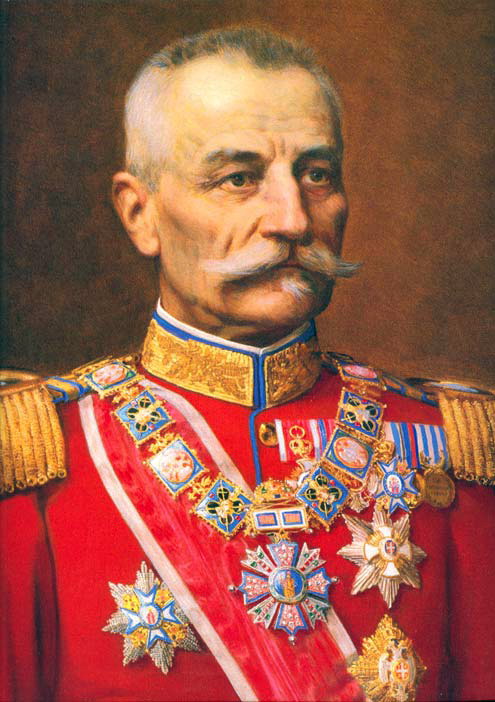- Peter I of Serbia
Infobox Serbian Royalty|majesty
name =Peter I
title =King of Serbs, Croats, and Slovenes; "prev." King of Serbia

reign =11 June 1903 –16 August 1921
coronation =15 July 1903
predecessor =Alexander I (Obrenović)
successor =Alexander I (Karageorgevich)
spouse =Princess Zorka of Montenegro
issue = Princess HelenGeorge, Crown Prince of Yugoslavia
Alexander I
royal house =House of Karageorgevich
royal anthem =God of Justice
father =Alexander Karađorđević, Prince of Serbia
mother =Persida Nenadović
date of birth =June 29 ,1844
place of birth =Belgrade
date of death =August 16 ,1921 (aged 77)
place of death =Belgrade
place of burial =Saint George's Church in Oplenac |Peter I (
Serbo-Croatian : Petar I Karađorđević/Петар I Карађорђевић) (29 June 1844 –16 August 1921 ), also known as King Peter the Liberator, wasKing of Serbia from 1903 to 1918 after which he became the first King of Serbs, Croats and Slovenes, which from the very beginning was colloquially called Yugoslavia within the kingdom and in the rest of Europe.Early life and exile (1844-1903)
Peter was born in
Belgrade to Prince Alexander of Serbia and his consort, Princess Persida Nenadović. Prince Alexander abdicated in 1858 and took his son with him into exile in present-dayRomania .The young noble spent much of his exile in
France , where he received an education and even participated in theFranco-Prussian War of 1871 as a French Army officer. On one occasion during the war, after being separated from his unit, he narrowly avoided capture by swimming across the near-frozenLoire River . During the Serb uprising againstOttoman Empire in 1876 in Bosnia and inHerzegovina , Peter took on the name Mrkonjic, a slavicized version of his last name, and joined the freedom fighters. He had to leave the region at the insistence of then-princeMilan Obrenovic , the ruler ofSerbia , who saw Peter as a rival and feared his popularity among the Serbian people. He married Princess Zorka of Montenegro, daughter of King Nicholas I, in 1883. They had five children: Princess Helen in 1884, Princess Milena in 1886, Prince George in 1887, Prince Alexander in 1888 and Prince Andrew in 1890. Princess Milena died at the age of one in 1887, and Prince Andrew, the last child, died in childbirth along with his mother.Peter returned to Serbia in 1903, when a military
coup d'état removed King Alexander from the throne. Peter was crowned King of Serbia on11 June .Reign (1903-1921)
The Western-educated King attempted to liberalise Serbia with the goal of creating a Western-style
constitutional monarchy , even translatingJohn Stuart Mill 's "On Liberty " into Serbian.Peter chose to "retire" due to ill health following the
Balkan Wars which, from a Serb perspective, were a great success. Executive power passed to his son Alexander.The King was relatively inactive during the
First World War , although he did occasionally visit trenches to check up on his troops. One memorable visit in 1915 involved Peter, by then 71, picking up a rifle and shooting at enemy soldiers. Following Serbia's military defeat to the forces of Austro-Hungary Peter led the army and civilian refugees through the mountains to the sea on a 'Calvary known to few peoples'. (R. Wolfson "Years of Change. European History 1890-1945")His last public appearance was on
1 December 1918 , when he was proclaimed King of Serbs, Croats and Slovenes. King Peter I died in Belgrade in 1921 at the age of 77.uccession
As his eldest son, Prince George was King Peter's presumed successor. This changed in 1909, when he kicked a servant to death in a fit of rage, after which the Crown Prince was forced to renounce his claim to the throne in favour of his brother Alexander.
Legacy
King Peter I is remembered for his modesty, attributed to his military background. He was immensely popular throughout his reign and remains one of the Western Balkans's most popular leaders. He is considered to be the founding father of Yugoslavia (this name, colloquial, but very widely used even in European maps during his day, became official in 1929).
His children were influential in European affairs as adults. His son, King Alexander, joined Yugoslavia with the West and helped foster the nascent Yugoslav national identity. His daughter, Princess Helen, married
Prince Ioann Konstantinovich of Russia who was killed in the Revolution.In
Paris , a street off theChamps-Élysées is named after him.infobox hrhstyles
royal name=King Peter I
dipstyle=His Majesty
offstyle=Your Majesty
altstyle=Sir orsire |
Wikimedia Foundation. 2010.
